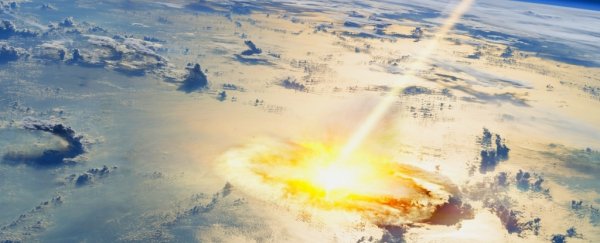Sixty-six million years ago, Earth had a very bad day indeed. A giant asteroid up to 81 kilometres (50 miles) across smashed into the coast of what is now Mexico near Chicxulub - an event thought to have triggered a wave of extinction that killed 75 percent of all life on Earth.
Now, thanks to painstaking work drilling into the rock below the Chicxulub crater to extract precious core samples 500 to 1,300 metres (1,640 to 4,265 feet) below the seafloor, geologists have managed to reconstruct what happened on that fateful day.
And boy, was it extreme. Melted rock, charcoal, and a curious absence of sulphur in the cores are some of the telltale signatures of the impact event.
"It's an expanded record of events that we were able to recover from within ground zero," said geophysicist Sean Gulick from the University of Texas. "It tells us about impact processes from an eyewitness location."
The asteroid triggered a tsunami that towered several hundred metres, dumping rock and dirt back in the crater at a tremendous rate - around 130 metres (425 feet) of material was deposited in just a single day, preserving an environmental record of the area in and around the crater in the first minutes and hours after impact.
 A section of one of the core samples. (International Ocean Discovery Program)
A section of one of the core samples. (International Ocean Discovery Program)
First, the impact site was a fiery hellscape. Then, the whole planet froze - resulting in the Cretaceous-Paleogene extinction event, which marks the end of the Cretaceous period, and the demise of non-avian dinosaurs.
"Not all the dinosaurs died that day, but many dinosaurs did," Gulick said.
The melted rock indicates that the asteroid hit with the force of 10 billion atomic bombs, setting forests aflame for thousands of kilometres, and triggering a tsunami that reached as far as current Illinois.
Then, when the tsunami waters receded, they dragged a bunch of material - including dirt (indicated by the presence of biomarkers associated with soil fungus) and charcoal from burnt trees - back into the fresh crater.
These events already would have had a dramatic impact on nearby ecosystems, but it's what happened next that truly changed the world. The clue lies in what the researchers didn't find there.
Namely, there was a remarkable absence of sulphur-bearing minerals, where usually they would be expected. This suggests that these rocks were vaporised by the impact, expelling tremendous amounts of sulphate aerosols into the atmosphere, where they blocked the light of the Sun, dramatically cooling Earth's temperatures for years after.
According to the researchers' calculations, somewhere around 325 billion metric tons of sulphur would have been ejected by the impact. That's four orders of magnitude higher than the sulphur spewed out during the 1883 Krakatoa eruption, which cooled the entire globe for five years after.
That sulphur, scientists believe, was the real killer - possibly exacerbated by later volcanic activity thought to have been triggered by the impact.
"The real killer has got to be atmospheric," Gulick said. "The only way you get a global mass extinction like this is an atmospheric effect."
The research has been published in PNAS.
